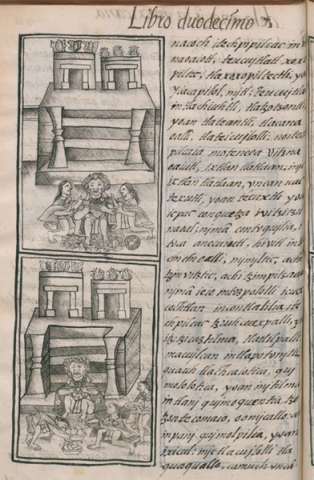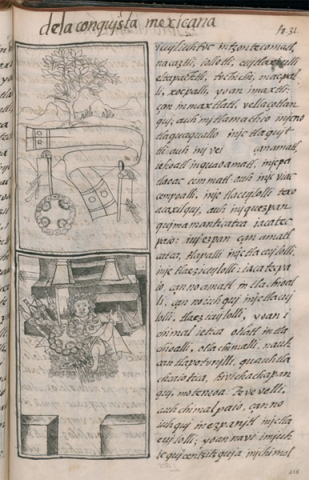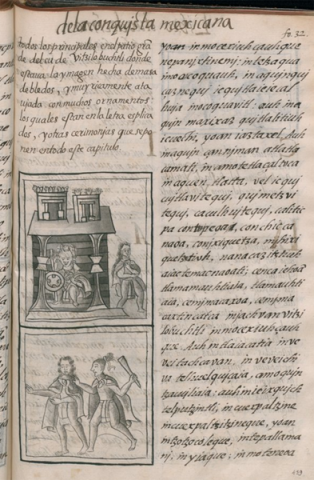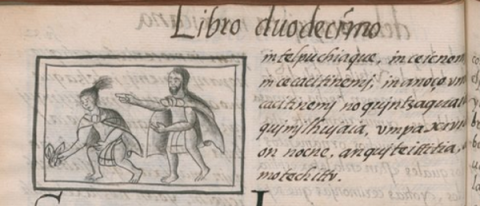 |
[Transcription of the Nahuatl (right-hand column) by James Lockhart:]
[f. 29v., cont.] Inic caxtolli onnavi capitulo: vncan mitoa in quenin Españoles, quinnaoatique Mexica; inic quichioazque inilhuiuh Vitzilobuchtli: auh inin amo ixpan muchiuh in Capitan; ca iquac in vmpa ia atenco inic acico Panphilo de narbayez.
Auh çatepan, niman ie ic quitlani in iilhuiuh vitzilo-buchtli, in quenami ilhuiuh, quimaviçoznequi quittaznequi, in quenami, in quenin muchioa: nimā ie ic tlanaoatia in Motecuçoma, in aquique vel oconcalaqui itechiuhcaoan, quioalquixtiaia in tlatolli. Auh in ovalquiztlatolli in vmpa caltzacutica motecuçoma: niman ie icquiteci in oauhtli chicalutl in cioa, mocexiuhçauhque, vncā in teu
|
[Translation of the Nahuatl (right-hand column) by James Lockhart:]
Nineteenth chapter, where it is said how the Spaniards ordered the Mexica to hold the festivity of Huitzilopochtli. But when this happened the Captain was not present, for at that time he went to the coast because of the arrival of Pánfilo de Narváez.
And afterward [Pedro de Alvarado] requested the festivity of Huitzilopochtli, wanting to see and behold how his festivity was and what sorts of things were done. Thereupon Moteucçoma gave the orders; those of his subordinates who could still enter [where he was] brought out the announcement. And when the announcement came out from where Moteucçoma was detained, then the women who had fasted for a year ground up the amaranth, the fish amaranth, in the temple courtyard.
[Translation of the Spanish (left-hand column) by James Lockhart:]
Chapter Nineteen, of how the Spaniards ordered the Indians to hold the festivity of Huitzilopochtli; this was in the absence of the Captain, when he went to the port because of the arrival of Pánfilo de Narváez.
When Captain don Hernando Cortés departed for the port to receive Pánfilo de Narváez, he left in his place, with the Spaniards who remained here in Mexico, don Pedro de Alvarado, who, in the absence of the Captain, encouraged Moteucçoma to order the festivity of Huitzilopochtli to be held, because they wanted to see how they performed these ceremonies. Moteucçoma ordered this festivity to be held to give pleasure to the Spaniards. Thus the satraps, as well as the leaders, prepared themselves to hold the festivity |
[Translation of the Nahuatl into Spanish by Fr. Bernardino de Sahagún; transcription of the Spanish (left-hand column) by James Lockhart:]
[f. 29v., cont.] Capitulo .19. de como los españoles mandaron a los yndios hazer la fiesta de Vitzilobuchtli: esto fue en absencia del capitan quando fue al puerto por la venida de Panphilo de narbayez.
Auiendose partido el capitan Dō hernando cortes, para el puerto a recebir a Paphilo de narbayez, dexo en su lugar a Don pedro de albarado con los españoles que quedaron aqui en mexico: el qual en absencia del capitan persuadio a Motecuçoma para que mādasse hazer la fiesta de Vitzilobuchtli, porque quieren ver como hazian aquello solēnidad. Motecuçoma mando que se hiziesse esta fiesta para dar cōtento a los españoles aparaejaronse ansi los satrapas como los principales, para hazer la fiesta.
|
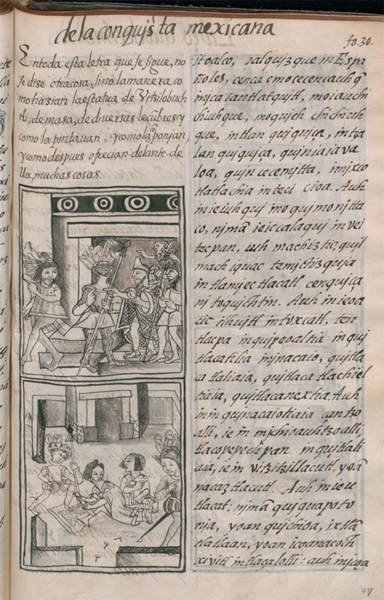 |
[Transcription of the Nahuatl (right-hand column) by James Lockhart:]
[f. 30r.] itoalco, oalquizque in Españoles, cencaomocecencauhq̄ in ica iautlatquitl, moiauchichiuhque, moquichchichiuhque, intlan quiquiça, intzalan quiquiça, quiniaiavaloa, quincecemitta, imixco tlatlachia in tecicioa. Auh in ie iuhqui in oquimonittaco, nimā ie ic calaqui in vei tecpan, iuh machiztic: quilmach iquac temictizquia intla miec tlacatl cenquiçani toquichtin.
Auh in ie oacic ilhuitl in toxcatl, teutlacpa in quipeoaltia in quitlacatilia in inacaio, quitlacatlaliaia, quitlacatlachieltiaia, quitlacanextia. Auh inin quinacaiotiaia çan tzoalli, ie in michioauhtzoalli, tlacopepechpan in quitlaliaia, ie in vitzitzillacutl, yoā nacaztlacutl.
Auh in ie utlacat, nimā quiquapotonia, yoan quichioa, ixtlā tlatlaan, yoan icoanacoch xivitl in tlaçalolli: auh in icoa
|
[Translation of the Nahuatl (right-hand column) by James Lockhart:]
The Spaniards came out well adorned in battle equipment, outfitted for war, arrayed as warriors. They passed among the grinding women, circling around them, looking at each one, looking upon their faces. And when they were through looking at them, they went into the great palace. It [later] became known, according to what is said, that they would have killed people at that time if many of the men had congregated.
And when the feast day of Toxcatl had arrived, toward sunset they began to give human form to [Huitzilopochtli’s] body. They formed it like a person, they made it look like a person, they gave it a person’s appearance. And what they made his body of was just dough of amaranth seed, fish amaranth seed. They placed it on a platform of sticks, “hummingbird sticks” and “ear sticks.”
And when it had become like a person, then they put feather-down on his head and painted his face, making his face striped, and they [put] serpent ear plugs on him, with turquoise glued on them. And from the serpent
[Translation of the Spanish (left-hand column) by James Lockhart:]
In all this subsequent text, nothing else is said except the way they made the statue of Huitzilopochtli from the dough of various vegetables, how they painted it, how they arranged it, and how afterward they offered many things before it.
|
[Translation of the Nahuatl into Spanish by Fr. Bernardino de Sahagún; transcription of the Spanish (left-hand column) by James Lockhart:]
[f. 30r.] En todo esta letra que se sigue, no se dize otra cosa, sino la manera como hazian la estatua de Vitzilobuchtli, de masa, de diuersas lecūbres y como la pintauan, y como la cōponian, y como despues ofrecian delante della, muchas cosas.
|
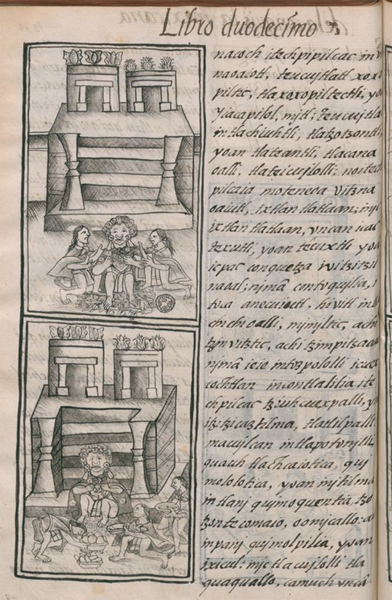 |
[Transcription of the Nahuatl (right-hand column) by James Lockhart:]
[f. 30v.] nacoch itech pipilcac in vitznaoaiotl, teucuitlatl xoxopiltic, tlaxoxopiltectli, yoā yiacapilol,mitl: Teucuitlatl in tlachiuhtli, tlatzotzontli, yoan tlateantli, tlacanaoalli, tlateicuilolli: no itech pilcaia moteneoa vitznaoaiutl, ixtlan tlatlaan; inic ixtlan tlatlaan, vncan icac texutli, yoan têcuxtli yoā icpac conquetza ivitzitzilnaoal; nimā contoquilia, itoca anecuiutl, hivitl intlachichioalli, mimiltic, achitzin vitztic, achi tzimpitzaoac: nimā ie* in tozpololli icuexcochtlan in contlalilia itech pilcac tziuhcuexpalli, yoā itzitzicaztilma, tlatlilpalli: macuilcan in tlapotonilli, quauhtlachcaiotica, quimololotica, yoan in itilma in tlani quimoquentia tzotzontecomaio, oomicallo: auh in pani quimolpilia, yoan ixicul: inic tlacuilolli tlaquaquallo, ca much vncā
----------
*IE. The word is inadvertently repeated in the manuscript.
|
[Translation of the Nahuatl (right-hand column) by James Lockhart:]
ear plugs hung rings of thorns, made of gold, like toes, cut like toes. And his nose rod was an arrow, made of hammered gold, set with stones, thinned and with stones scattered on it. Also from it hung what is called the huitznahuayotl [ring of thorns]. It was <painted with stripes> on the surface, and the manner of its being painted on the surface was with blue and yellow. On his head they placed his hummingbird totem. They followed that with what is named an aneucyotl, arranged of feathers, cylindrical, a bit pointed at the bottom. Then they placed at the back of his neck a <ball of yellow parrot feathers>, from which hung a boy’s lock of neck-hair. And he had a cloak of nettles, colored black, feathered in five places with eagle down, that he gathered about himself. Below he wore a cape covered with skulls and bones, and above he wrapped himself also in a sleeveless jacket, painted in tlaquaquallo [chewed-up] style, for there
[Translation of the Spanish (left-hand column) by James Lockhart:]
(intentionally blank)
|
[Translation of the Nahuatl into Spanish by Fr. Bernardino de Sahagún; transcription of the Spanish (left-hand column) by James Lockhart:]
[f. 30v., dos dibujos; sin texto en español]
|
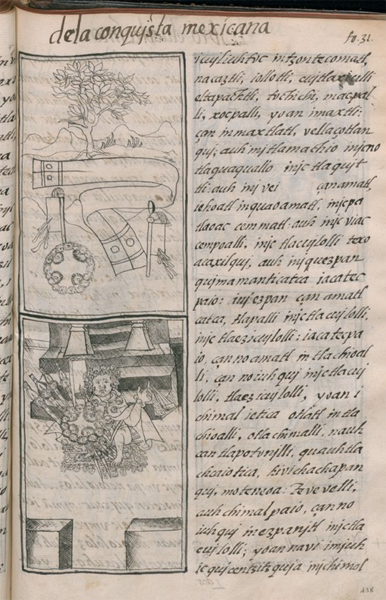 |
[Transcription of the Nahuatl (right-hand column) by James Lockhart:]
[f. 31r.] icuiliuhtoc in tzontecomatl, nacaztli, iollotli, cuitlaxculli eltapachtli, tochichi, macpalli, xocpalli, yoanimaxtli: çan in maxtlatl, vellaçotlanqui: auh in itlama chio inic no tlaquaquallo inic tlaquittli: auh in ivei [maxtli]* çan amatl, iehoatl in quaoamatl, inic patlaoaccemmatl: auh inic viac cempoalli, inic tlacuilolli texoacaxilqui,** auh in iquezpan quimamanticatca iacatecpaio: in iezpan çan amatl catca, tlapalli inic tlacuilolli, inic tlaezicuilolli: iacatecpaio, çanno amatl in tlachioalli, çanno iuhqui inic tlacuilolli, tlaezicuilolli, yoanichimal ietica otlatl in tlachioalli, otlachimalli, nauhcan tlapotonilli, quauhtlachcaiotica, hivichachapanqui, moteneoa: Tevevelli, auh chimalpaio, çanno iuhqui in ezpanitl inic tlacuilolli; yoan navi imiuh ic quicentzitzquia in ichimal
----------
*IVEI[MAXTLI]. The element "-maxtli," the possessed form of maxtlatl 'loincloth', was omitted in the manuscript, though an empty space has been left where it should have been.
**TEXOACAXILQUI. Here I rely on Sahagún 1950–1982: 13.53.
|
[Translation of the Nahuatl (right-hand column) by James Lockhart:]
were painted all severed heads, ears, hearts, entrails, livers, lungs, hands, and feet. And he had a simple loincloth, but his loincloth was very precious. It too had the tlaquaquallo motif woven into its design. His large loincloth was just of paper, paper from tree bark, a matl wide and twenty long, painted with a blue <striped design>. And at his hips he carried a blood banner, just of paper, with a flint knife at the point [of the staff]; it was painted with [red] color, painted like blood. And the flint knife at the point was likewise made of paper, painted the same way, painted like blood. And the shield he had was made of strong reeds, a reed shield, feathered in four places with eagle down, sprinkled with feathers. It is called a tehuehuelli. And it had a shield banner, painted like the blood banner. And he held four arrows together with his shield.
[Translation of the Spanish (left-hand column) by James Lockhart:]
(intentionally blank)
|
[Translation of the Nahuatl into Spanish by Fr. Bernardino de Sahagún; transcription of the Spanish (left-hand column) by James Lockhart:]
[f. 31r., dos dibujos; sin texto en español]
|
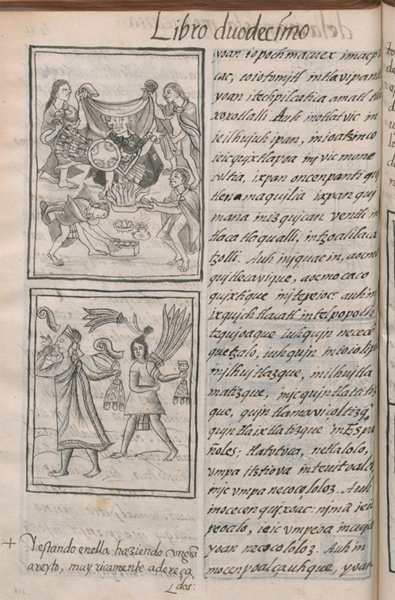 |
[Transcription of the Nahuatl (right-hand column) by James Lockhart:]
[f. 31v.] yoan iopochmacuex imac pilcac, coiotomitl in tlavipantli, yoan itech pilcatica amatl tlaxoxotlalli.
Auh in otlatvic in ie ilhuiuh ipan, in ioatzinco ie icquixtlapoa in ivic monetoltia, ixpan oncenpanti quitlenamaquilia ixpan quimana in izquican ventli in tlacatlaqualli, in tzoalilacatzolli. Auh in iquac in, aocmo quitlecavique, aocmo cacoquixtique in itepeioc: auh in ixquich tlacatl in telpopochtequioaque iuhquin nececē quetzalo, iuhquin inioiolipā* in ilhuitlazque, in ilhui-tlamatizque, inic quintlattitizque, quintlamaviçoltizq̄, quintlaixtlatizque, in Españoles:
tlatotoca, netlalolo, vmpa itztiova in teuitoalco, inicvmpa necocololoz. Auh in ocecenquixoac: nimā ie ic peoalo, ie ic vmpeoa in cuico yoan necocololoz. Auh inmocenpoalçauhque, yoan
----------
*IUHQUIN NECECEQUETZALO, IUHQUIN INIOIOLIPĀ. The same uncertainties with these idioms obtain as on fol. 28v., where they are also used in tandem.
|
[Translation of the Nahuatl (right-hand column) by James Lockhart:]
And from his left arm hung an arm band, arranged of coyote fur, and from it hung strips of paper.
And when it had dawned and was already the day of his festivity, very early in the morning those who had made vows to him unveiled his face. Forming a single row before him they offered him incense; each in his place laid down before him offerings of food for fasting and rolled amaranth dough. And at this time they no longer took him up or raised him to the top of his temple. And it was as though all the youthful warriors had gathered together and had hit on the idea of holding and observing the festivity in order to show the Spaniards something, to make them marvel and instruct them.
Everyone ran and scurried in the direction of the temple courtyard for the snake dancing there. And when all had assembled, singing and snake dancing began. Those who had fasted for twenty days and
[Translation of the Spanish (left-hand column) by James Lockhart:]
During [the ceremonies] all the leaders, very richly costumed,
|
[Translation of the Nahuatl into Spanish by Fr. Bernardino de Sahagún; transcription of the Spanish (left-hand column) by James Lockhart:]
[f. 31v.] Y estando en ella haziendo vn grā areyto, muy ricamente adereçados:
|
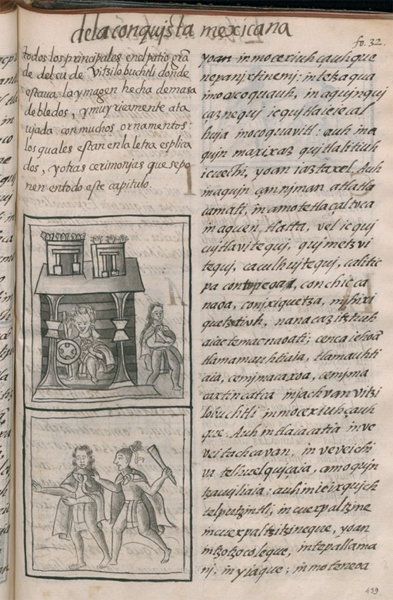 |
[Transcription of the Nahuatl (right-hand column) by James Lockhart:]
[f. 32r.] yoan in mocexiuhçauhque nepanixtinemi: in tetzaqua imoocoquauh, in aquinquiçaznequi ic quitlaieiecalhuia in ocoquavitl: auh inaquin maxixaz quitlalitiuh icuechi,* yoan iaztaxel. Auh in aquin çan niman atlatlacamati, in amo tetlaçaltoca in aquen tlatta, vel ic quicuitlavitequi, quimetzvitequi,caculhuitequi, caliticpa contopeoa, conchiccanaoa, conixiquetza, mihixiquetztiuh, nanacazitztiuh aiac temac naoati;
cenca iehoā tlamamauhtiaia, tlamauhtiaia, cemima-caxoa, cemimacaxtin catca in iachvan vitzilobuchtli in mocexiuhçauhque. Auh in tlaiacatia in vevei tachcavan, in veveichiva tel huel quiçaia, amo quintzacuiliaia: auhin ie ixquich telputzintli, in cuexpaltzine in cuexpaltzitzineque, yoan in tzotzocoleque, in tepallamani, inyiaque: in moteneoa
----------
*ICUEUCHI. Here I have followed Sahagún 1950-1982: 13.53.
|
[Translation of the Nahuatl (right-hand column) by James Lockhart:]
those who had fasted for a year <went about jointly>. Their pine rods detained people; they brandished the pine rod sat anyone who tried to leave. Anyone who needed to [leave to] relieve himself put down his net cape and his forked heron feather ornament <as a signal>. When anyone absolutely would not obey, [would not accept punishment], was insolent, because of that they beat him soundly on the back, the thighs, the shoulders. They shoved him outside the precinct, they threw him out,pushing him so he fell flat on his face; he went out on his face, on his ear. No one in [their] hands made a sound.
The helpers of Huitzilopochtli, those who had fasted for a year, inspired great and general fear, they were respected by all, they were persons of universal authority. Those who went in the lead [of the dance], the great leaders, who had done great things, were able to pass,and they did not detain them. But as to all the youths,those with a lock of hair behind the head and those with the jar-shaped headdress, who had taken a captive with the help of others, <the leaders>, called
[Translation of the Spanish (left-hand column) by James Lockhart:]
were performing a great dance in the great square of the cu of Huitzilopochtli where the image made of amaranth dough was, very richly decorated with many ornaments, which are explained in the text, as well as other ceremonies that are included throughout this whole chapter.
|
[Translation of the Nahuatl into Spanish by Fr. Bernardino de Sahagún; transcription of the Spanish (left-hand column) by James Lockhart:]
[f. 32r.] todos los principales en el patio grāde del cu de Vitzilobuchtli donde estaua la ymagen hecha de masa de bledos, y muy ricamente atauiada con muchos ornamentos: los quales estan en la letra esplicados, y otras cerimonias que se ponen en todo este capitulo.
|
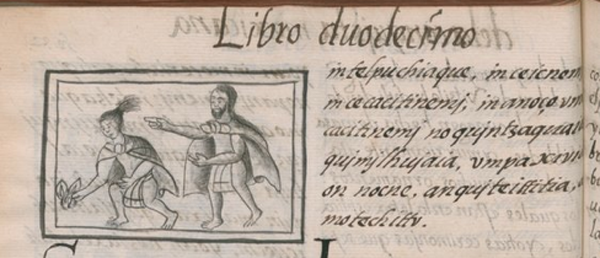 |
[Transcription of the Nahuatl (right-hand column) by James Lockhart:]
[f. 32v.] in telpuchiaque,* in ce ic nemi, in ce cacitinemi, in anoço vme cacitinemi no quintzaquaia: quimilhuiaia, vmpa xiviā on nocne, anquiteittitia, amotech itto.
----------
*IN YIAQUE: . . . IN TELPUCHIAQUE. Here I have followed Sahagún 1950–1982: 13.54; I have been unable to identify the form "yiaque" or "iaque." Conceivably it could be the plural of yaqui, a preterit agentive from yauh 'to go', with the meaning "one who has gone," but no such usage has come to my attention. The y added to the first example makes one think of the word iyac 'something or someone with a stench'.
|
[Translation of the Nahuatl (right-hand column) by James Lockhart:]
youth <leaders>, who had gone and taken one or perhaps two captives, they also detained them, saying to them, “Get along with you, rascals, you are showing [bad] things to people, they are taking an example from you.”
[Translation of the Spanish (left-hand column) by James Lockhart:]
(intentionally blank)
|
[Translation of the Nahuatl into Spanish by Fr. Bernardino de Sahagún; transcription of the Spanish (left-hand column) by James Lockhart:]
[f. 32v., un dibujo; sin texto en español]
|


